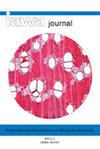从生理学角度评价卡尔奎斯特定律
IF 3.5
3区 农林科学
Q2 FORESTRY
引用次数: 0
摘要
“卡尔奎斯特定律”是一种引人注目的血管植物木材解剖特征之间的联系模式。这源于Sherwin Carlquist的观察,即当木质部导管嵌入似乎具有导电性的无孔管状元体基质中时,木质部导管往往是孤立的,而当木质部血管被看似不导电的细胞包围时,它们往往是成组的。血管-血管接触(血管分组)允许水在导管之间流动,但也为空气从栓塞(充气)血管传播到功能性血管提供了途径。如果背景基质是导电的,可以想象水可以绕过栓塞的血管,为具有导电背景和孤立血管的物种提供一种替代的运输途径。在这一假设中还有很多有待检验的地方,包括具有单独血管和成组血管的物种的血管网络拓扑结构,以及不同的无孔气管元件类型的导电性。探索Carlquist定律有望为深入了解植物导管中栓塞的原因、导管之间栓塞的通道模式,以及血管和它们所嵌入的细胞如何相互作用以控制植物中的水流路径提供关键见解。本文章由计算机程序翻译,如有差异,请以英文原文为准。
Evaluating Carlquist’s Law from a physiological perspective
“Carlquist’s Law” is a striking pattern of association between anatomical features in the wood of vessel-bearing plants. It derives from Sherwin Carlquist’s observation that xylem vessels tend to be solitary when embedded in a matrix of imperforate tracheary elements that appear to be conductive, whereas xylem vessels tend to be grouped when surrounded by seemingly non-conductive cells. Vessel-vessel contacts (vessel grouping) allow water to travel between conduits, but also provide pathways for air to propagate from embolized (air-filled) vessels into functional vessels. If the background matrix is conductive, it is conceivable that water could bypass embolized vessels, providing an alternative transport route in species with conductive backgrounds and solitary vessels. Much remains to be tested in this hypothesis, including the topology of the vessel networks in species with solitary versus grouped vessels and how conductive the different imperforate tracheary element types are. Exploring Carlquist’s Law promises to provide key insight into the causes of embolism in plant conduits, the modes of embolism passage between conduits, and how vessels and the cells in which they are imbedded may interact to govern the pathways of water flow through plants.
求助全文
通过发布文献求助,成功后即可免费获取论文全文。
去求助
来源期刊

IAWA Journal
农林科学-林学
CiteScore
3.40
自引率
15.80%
发文量
26
审稿时长
>36 weeks
期刊介绍:
The IAWA Journal is the only international periodical fully devoted to structure, function, identification and utilisation of wood and bark in trees, shrubs, lianas, palms, bamboo and herbs. Many papers are of a multidisciplinary nature, linking
 求助内容:
求助内容: 应助结果提醒方式:
应助结果提醒方式:


